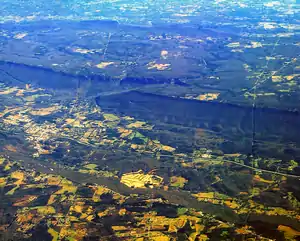Escarpment
An escarpment is a steep slope or long cliff that forms as a result of faulting or erosion and separates two relatively level areas having different elevations.

The terms scarp and scarp face are often used interchangeably with escarpment. Some sources differentiate the two terms, with escarpment referring to the margin between two landforms, and scarp referring to a cliff or a steep slope.[1][2] In this usage an escarpment is a ridge which has a gentle slope on one side and a steep scarp on the other side.
More loosely, the term scarp also describes a zone between a coastal lowland and a continental plateau which shows a marked, abrupt change in elevation[3] caused by coastal erosion at the base of the plateau.
Formation and description
Scarps are generally formed by one of two processes: either by differential erosion of sedimentary rocks, or by movement of the Earth's crust at a geologic fault. The first process is the more common type: the escarpment is a transition from one series of sedimentary rocks to another series of a different age and composition. Escarpments are also frequently formed by faults. When a fault displaces the ground surface so that one side is higher than the other, a fault scarp is created. This can occur in dip-slip faults, or when a strike-slip fault brings a piece of high ground adjacent to an area of lower ground.

Earth is not the only planet where escarpments occur. They are believed to occur on other planets when the crust contracts, as a result of cooling. On other Solar System bodies such as Mercury, Mars, and the Moon, the Latin term rupes is used for an escarpment.
.jpg.webp)
Erosion
When sedimentary beds are tilted and exposed to the surface, erosion and weathering may occur. Escarpments erode gradually and over geological time. The mélange tendencies of escarpments results in varying contacts between a multitude of rock types. These different rock types weather at different speeds, according to Goldich dissolution series so different stages of deformation can often be seen in the layers where the escarpments have been exposed to the elements.
Significant escarpments
Africa
- Elgeyo escarpment (Great Rift Valley)
- Great Escarpment, Southern Africa
- Including the Drakensberg and God's Window in Mpumalanga's Eastern Escarpment
- Bandiagara Escarpment (Mali)
- Zambezi Escarpment (Zambia)
- East coast, Madagascar
Antarctica
Asia
- Alam-Kuh, Iran
- Sharon Escarpment, Israel
- Tuwaiq, Saudi Arabia
- Vindhya Range, India
- Western Ghats, India
- Wulian Feng, China
Australia and New Zealand
- Australia
- New Zealand
- The western slope of the Southern Alps (along the Alpine Fault)
- The Kaimai escarpment, above the Hauraki Plains
- The Paekakariki escarpment between Paekakariki and Pukerua Bay (with State Highway 59 and the North Island Main Trunk).
Europe
- England
- Cotswold escarpment
- Chiltern escarpment
- North Downs
- South Downs
- A common placename denominating an escarpment in England is "edge" as in
- Alderley Edge
- Edge Hill famous as the place of the first battle of the English Civil War
- Kinver Edge
- The Lincoln Edge
- Stanage Edge
- Wenlock Edge
- Scotland
- Wales
- France
- La Côte d'Or is famous for its wines and has given its name to a département, Côte-d'Or.
- Le Pays de Bray, a clay vale enclosed by chalk escarpments.
- Sweden, Estonia and Russia
- Baltic Klint
- Gotland–Saaremaa Klint
- South Småland-Sub-Cambrian escarpment[4]
- Malta
- Victoria Lines

North America

- Atlantic Seaboard Fall Line
- Florida Escarpment, Gulf of Mexico
- Sigsbee Escarpment, Gulf of Mexico
- Canada and the United States
- Manitoba Escarpment (Manitoba, Saskatchewan)
- Pembina Escarpment (Manitoba, North Dakota)
- Niagara Escarpment (east to west: New York, Ontario, Michigan, Wisconsin, and Illinois)
- Eardley Escarpment (Mattawa Fault, Gatineau Park, Quebec)
- Onondaga (geological formation) (Ontario and New York)
- Devil's Rock (Lake Temiskaming, Ontario)
- Scarborough Bluffs (Toronto, Ontario)
- United States
- Allegheny Front (West Virginia-Maryland-Pennsylvania)
- Blue Ridge Escarpment (North Carolina–Virginia)
- Balcones Fault (Texas)
- Bergen Hill (New Jersey)
- Black River Escarpment (Wisconsin)
- Book Cliffs (Colorado–Utah)
- Caprock Escarpment (Texas)
- Catskill Escarpment (New York)
- The Chinese Wall (Montana)
- Cody Scarp (Florida)
- Devil's Slide (California)
- Helderberg Escarpment (New York)
- Hell's Half Acre (Wyoming)
- Knobstone Escarpment (Indiana)
- Lewiston Hill (Idaho-Washington)
- Magnesian Escarpment (Wisconsin)
- Mescalero Ridge (New Mexico)
- Missouri Escarpment (North Dakota)
- Mogollon Rim (Arizona)
- Muldraugh Hill (Kentucky)
- Pine Ridge (Nebraska–South Dakota)
- Portage Escarpment (Ohio)
- Potrero Hills in (California)
- Pottsville Escarpment (Kentucky–Tennessee)
- The Rimrocks (Montana)
- Sierra Nevada eastern slope (California)
- The Caribbean
- Bahamas Escarpment (Bahamas)
South America
- Brazil
- Chile
- West Andean Escarpment[5]
See also
- Cuesta – Hill or ridge with a gentle slope on one side and a steep slope on the other
- Fall line – Meeting point of uplands and coastal plain
- List of geological features on Mercury
- Rupes – Landform on other planets
References
- Easterbrook, Don J. (1999). Surface Processes and Landforms. Prentice Hall. ISBN 978-0-13-860958-0.
- Summary: Escarpments, US Army Corps of Engineers.
- "Scarps and Terraces". Physiography. Radford University. Retrieved 24 December 2020.
- Lidmar-Bergström, Karna (1988). "Denudation surfaces of a shield area in southern Sweden". Geografiska Annaler. 70 A (4): 337–350. doi:10.2307/521267. JSTOR 521267.
- Wörner, Gerhard; Uhlig, Dieter; Kohler, Ingrid; Seyfried, Hartmut (15 February 2002). "Evolution of the West Andean Escarpment at 18°S (N. Chile) during the last 25 Ma: uplift, erosion and collapse through time". Tectonophysics. 345 (1): 183–198. Bibcode:2002Tectp.345..183W. doi:10.1016/S0040-1951(01)00212-8.